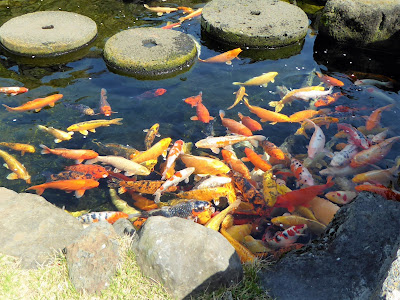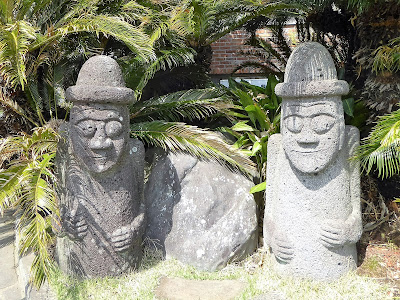There will be two port calls included in this posting – Incheon and Jeju Island, both in South Korea.
April 7 – Incheon, South Korea
Incheon (also sometimes spelled Inchon) is a port city, located about 25 miles from the heart of Seoul – the capital of South Korea, as well as one of the most populous cities in the world.
It was interesting watching how difficult it was to enter the port of Incheon this morning. Jim had a front row vantage point, as all this occurred while he was out doing his daily 3-mile walk. It was necessary for Serenity to slowly enter a very narrow lock, which had only about one-foot clearance on each side of the ship. He doesn’t remember whether we went up or down in the lock, but eventually the ship left the lock to go to our docking station. While we were in the lock, the ship was unfortunately scraping the sides of the lock on both sides.
We were scheduled for a shore excursion this morning, but it was canceled. The reason given was that not enough people had signed up for the tour. We’re not sure why that was, as the tour, “Pottery Making Experience,” seemed interesting. But it would have involved a long bus ride to get there (at least 90 minutes each way), and many people were probably weary after all the bus riding we experienced in Beijing. There were several additional shore excursions being offered to Seoul, but they were each 7 - 7½ hours in duration and also involved long bus rides. A tour to visit the Demilitarized Zone (DMZ) between North and South Korea was a shorter distance away, but that tour had a long waiting list.
Jim had visited Seoul a few times before, so he was very aware of the size and frenetic activity level in the city. He didn’t feel the need to pay for a long ride on the “motor coach transfer” being offered by Crystal at a cost of $59 roundtrip, for passengers who wanted to explore Seoul independently. So we opted to stay on board ship today.
Strangely, there were no facilities for passengers (and no passenger terminal) at all in the location where we were docked, and no apparent security. Jim did get off the ship in the afternoon, with the intention of walking into town. He walked for about a mile (20 minutes) inside the port, going past warehouses, several cargo ships, and weaving through container trucks, until he finally reached the exit gate. There he found a small but very busy, overworked Customs and Immigration Office. There was a formidable crowd of grumbling departing and arriving Crystal passengers and crew members (with suitcases) all waiting in a long line to get into the building. Jim thought maybe he didn’t need to get in the line, if all he wanted to do was walk into town, but the gate guard refused to allow him out of the port without paperwork signed by the Customs and Immigration Office. Discouraged by size of the line, he walked the one mile back to the Serenity and re-boarded the ship.
More than 60 years ago (1950), Incheon was the center of world attention when General Douglas MacArthur led UN forces in an amphibious landing at Inchon that led to the recapture of Seoul, turning the tide of the Korean War. All we can tell you from today’s visit is that Incheon is now a busy industrial city and port. Here’s what it looked like from our balcony on the ship:
We were quite impressed with these plans and the articulate answers Ms. Rodriguez gave to passengers’ questions. One cannot help but think that the corporation has a very strong leader and ambitious, but insightful, plans for the future.
Jeju Island is South Korea’s largest island, and it lies about 55 miles off the south coast of the mainland of Korea. This is some 300 miles south of Seoul, which is in the northwest corner of South Korea (near the DMZ). It’s an island of volcanic origin, with many rolling hills, one large dormant volcano – Mount Halla – with elevation of 6,400 feet (the tallest mountain in South Korea), and more than 300 small conical shaped hills that our tour guide Ella called “risings.”
Jim had been looking forward to visiting Jeju (formerly called Cheju), as he remembered hearing (many years ago) that it was the favorite vacation spot for Koreans (especially for honeymooners). We’re happy to report that it lived up to its billing as a unique getaway spot, but we also learned one of the primary reasons why it was so popular. Ella told us that until 1989 South Korean citizens were not allowed by their government to travel outside of Korea. Thus the popularity of this island for Korean vacationers before 1989. We were told that, with the lifting of the travel ban, it has lost some of its appeal with honeymooners. But the natural scenery is quite appealing, and we can imagine it still seems like a world away for the crowded residents on the mainland of Korea.
We signed up for a shore excursion today, titled “Spirited Jeju Tour.” There were two buses for this tour, and we left the terminal at about 1:00 pm. It was a 1-hour ride to our first stop, and we first passed through Jeju, the main city of the island (with the same name). It isn’t really a tourist town, but it seemed like a neat, clean, and pleasant city with wide avenues and plenty of shops, cafés, and restaurants. We’ve read that the population of the city is close to 400,000 while the whole island’s population is 605,000; the island as a whole is said to be 45 miles long and 19 miles wide.
Because of the distance to be traveled, we only had two primary attractions that we visited. Along the way to the first one, we slowed down a little at Mysterious Hill. This involves an optical illusion – the driver of the bus came to a complete stop, removed the keys from the ignition, and the bus started rolling downhill on its own. Ella told us that it was actually a 3º downward slope, even though it looks uphill to the human eye.
Our first stop at the Spirited Garden was the highlight of the day. This is one of the most beautiful and interesting gardens we’ve ever seen, with an outstanding and fascinating outdoor Banzai collection that must number in the hundreds. Each tree is a masterpiece created by Mr. Bum Yung-sung, whom we understand is a multi-awarded gardener who has been working on the Banzai trees for more than 30 years.
Landscaping of the grounds is peaceful and green, on difficult, rocky terrain. There are two waterfalls and an octagonal pavilion decorated with stones native to Jeju Island. Two more attractions here include the large collection of colorful carp fish and a special restroom with heated toilet seats. Jim says he’s no longer happy with our old toilet seats at home. No, he didn’t take a picture of this wonderful toilet attraction.
We arrived on schedule at 10:00 this morning and found that there’s a new passenger terminal and docking facilities for cruise ships on the island. That made Ginny very happy, because the original materials we received for the World Cruise stated that a tender would be required here.
Jim had been looking forward to visiting Jeju (formerly called Cheju), as he remembered hearing (many years ago) that it was the favorite vacation spot for Koreans (especially for honeymooners). We’re happy to report that it lived up to its billing as a unique getaway spot, but we also learned one of the primary reasons why it was so popular. Ella told us that until 1989 South Korean citizens were not allowed by their government to travel outside of Korea. Thus the popularity of this island for Korean vacationers before 1989. We were told that, with the lifting of the travel ban, it has lost some of its appeal with honeymooners. But the natural scenery is quite appealing, and we can imagine it still seems like a world away for the crowded residents on the mainland of Korea.
We signed up for a shore excursion today, titled “Spirited Jeju Tour.” There were two buses for this tour, and we left the terminal at about 1:00 pm. It was a 1-hour ride to our first stop, and we first passed through Jeju, the main city of the island (with the same name). It isn’t really a tourist town, but it seemed like a neat, clean, and pleasant city with wide avenues and plenty of shops, cafés, and restaurants. We’ve read that the population of the city is close to 400,000 while the whole island’s population is 605,000; the island as a whole is said to be 45 miles long and 19 miles wide.
Because of the distance to be traveled, we only had two primary attractions that we visited. Along the way to the first one, we slowed down a little at Mysterious Hill. This involves an optical illusion – the driver of the bus came to a complete stop, removed the keys from the ignition, and the bus started rolling downhill on its own. Ella told us that it was actually a 3º downward slope, even though it looks uphill to the human eye.
Our first stop at the Spirited Garden was the highlight of the day. This is one of the most beautiful and interesting gardens we’ve ever seen, with an outstanding and fascinating outdoor Banzai collection that must number in the hundreds. Each tree is a masterpiece created by Mr. Bum Yung-sung, whom we understand is a multi-awarded gardener who has been working on the Banzai trees for more than 30 years.
The only quiet part of the museum was the collection of antique teacups. After about five minutes of that, we entered the next room, where mobs of people were circulating through the store while looking for the perfect O’Sulloc tea to buy. Think of the Tokyo subway system at rush hour – that’s what it felt like. We joined the throng and found a small selection of Cherry Blossom Tea. We didn’t think we could fit any more than that in our luggage. Even worse was the snack bar. Everyone in Korea must have a compulsion to eat green tea ice cream at this museum on Jeju Island at least once in their lives. We avoided that by going outside and heading back to the bus.
For us, the best part of the day (in addition to the Bonzai Garden) was driving around the island. We did see quite a few fields of tea; according to our guide Ella, the subtropical weather on Jeju is ideal for growing tea. There are also a lot of Mandarin trees, for which the island is also well known. In addition to these crops, the farmers also grow garlic, potatoes, and barley.
In a half day, it was impossible for us to get a full idea of Jeju Island, but we can say that they have very attractive natural scenery, and they're remote from the mainland of Korea. All this added up 12 million visitors to the island last year.
Jim & Ginny








No comments:
Post a Comment